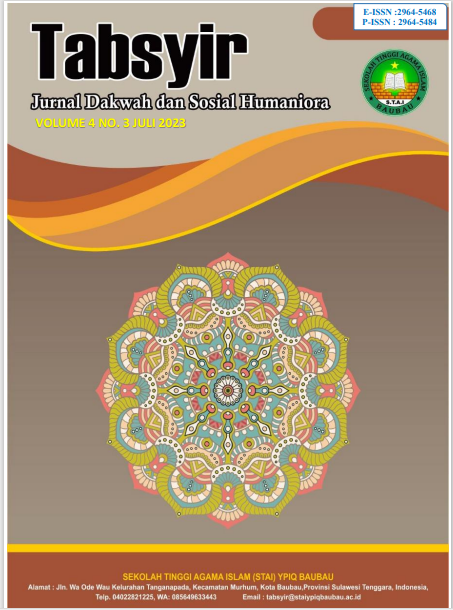Larangan Menistakan Agama Dalam Al-Qur’ân Antara Fardu Ain dan Kifayah: Studi Komparatif Atas Tafsir Ibn Katsîr dan Tafsir Al-Mishbâh
DOI:
https://doi.org/10.59059/tabsyir.v4i3.218Keywords:
Obligation of proselytizing, Prohibition of blasphemy, genetic structuralism, Comparative Studies, Tafsir Ibn Katsîr and Tafsir al-MishbâhAbstract
Today, in times of increasingly complex public problems and the need for religious references has escalated, there is a spirit to answer this with individual and collective da'wah movements. This condition in the opinion of researchers is very good, but often there is a bias in the basic understanding of who is actually entitled and obliged to convey da'wah (who has the right to prohibit blasphemy) and how the law is actually based on the perspective of the Qur'an. The purpose of this study to explore the interpretation of Ibn Katsîr and M. Quraish Shihâb regarding the obligation of Da'wah and the implications of the sociohistorical background of both. The approach used in this study is qualitative with comparative study method. Data collection techniques in the form of literature and observation studies were analyzed in the form of descriptive data collection techniques with the method of comparative analysis (analytical-comparative method). The results showed that there are differences in the tendency of interpretation as well as interpretation between Ibn Katsîr with M. Quraish Shihâb. Ibn Katsîr directed the obligation of Da'wah (which has the right to prohibit blasphemy) as an individual obligation while M. Quraish shihâb directs the tendency of the interpretation of the obligation as a collective obligation also with some similarities in the interpretation of which still accommodate obligations that are not used as a tendency of interpretation
References
Abu al-Fath al-Bayanuni. (2001). Al-Madkhal ila al-‘Ilm ad-Da’wah. ar-Resalah Publishing.
Amsori, A. (2017). Al-Ahkam Al-Khams Sebagai Klasifikasi Dan Kerangka Nalar Normatif Hukum Islam: Teori Dan Perbandingan. PALAR (Pakuan Law Review), 3(1). https://doi.org/https://doi.org/10.33751/palar.v3i1.400
Baqi, F. A. (1945). Al-Mu’jam al-Mufaharras li Alfâdz Al-Qur’ân. Dar al-Kutub Misriyah.
Izad, R. (2017). Fenomena Penistaan Agama Dalam Perspektif Islam Dan Filsafat Pancasila (Studi Kasus terhadap Demo Jilid II pada 04 November 2016). Panangkaran: Jurnal Penelitian Agama Dan Masyarakat, 1(1), 171–189.
Kusroni, K. (2019). Mengenal Ragam pendekatan, metode, dan corak dalam penafsiran al-Qur’an. Kaca (Karunia Cahaya Allah): Jurnal Dialogis Ilmu Ushuluddin, 9(1), 89–109. https://doi.org/https://doi.org/10.36781/kaca.v9i1.2988
Mahmud, A. (2011). Dakwah Islam, diterjemahkan oleh Mahbubah dari judul ad- Da’wah ila al-Islâm. Pustaka Thariqul Izzah.
Maliki, M. (2018). Tafsir Ibn Katsir: Metode Dan Bentuk Penafsirannya. El-Umdah, 1(1), 74–86. https://doi.org/https://doi.org/10.20414/elumdah.v1i1.410
Munawwir, A. W. (1984). Kamus Munawwir. Pustaka Progresif.
Mustaqim, A. (2019). Metode Penelitian Al-Qur’ân dan Tafsîr. Idea Press.
Muttaqin, C. T. (2018). METODE DAKWAH DALAM AL-QUR’ÂN (Studi Komparatif Penafsiran Ayat-Ayat Dakwah dalam Kitab Tafsir al-Azhar Karya Hamka dan Kitab Tafsir an-Nûr Karya Hasbi Ash-Shidieqy). Al Karima: Jurnal Studi Ilmu Al Quran Dan Tafsir, 1(2), 1–16.
Nawawi, A. M. (2016). Hemeneutika Tafsîr Maudhû’I ,. Suhuf, 9(1), 9.
Nawawi, A. M. N. (2019). Dakwah Islam Moderat dan Realitas Politik Identitas dalam Masyarakat Meme. Jurnal Bimas Islam, 12(1), 69–92. https://doi.org/https://doi.org/10.37302/jbi.v12i1.100
Permana, A., Mawardi, H., & others. (2018). Jaringan Habaib di Jawa Abad 20. Al-Tsaqafa: Jurnal Ilmiah Peradaban Islam, 15(2), 155–180.
Rouf, A. (2020). AL-QUR’AN DALAM SEJARAH (Diskursus Seputar Sejarah Penafsiran al-Qur’an). Al Amin: Jurnal Kajian Ilmu Dan Budaya Islam, 3(01), 1–17. https://doi.org/https://doi.org/10.36670/alamin.v3i1.34
Shihab, M. Q. (2013). Kaidah Tafsîr: Syarat, Ketentuan dan Aturan yang Patut Anda Ketahui dalam Memahami Ayat-ayat Al-Qur‟an,. Lentera Hati.
Sugiyono. (2017). Metode Penelitian Kuantitatif, Kualitatif dan R&D (26th ed.). Alfabeta.
Syeikh, A. K. (2018). Rekonstruksi Makna Dan Metode Penerapan Amar Ma’ruf Nahi Munkar Berdasarkan Al-Qur’an. Al-Idarah: Jurnal Manajemen Dan Administrasi Islam, 2(2), 1–22. https://core.ac.uk/download/pdf/228451279.pdf
Wartini, A. (2014). Corak penafsiran M. Quraish Shihab dalam tafsir al-Misbah. Hunafa: Jurnal Studia Islamika, 11(1), 109–126. https://doi.org/https://doi.org/10.24239/jsi.v11i1.343.109-126
Yusri, D. (2014). Konsep Khilafah dalam Alquran (Studi komparatif terhadap tafsir Ibn Kasir dan Tafsir Al-Misbah). Pascasarjana UIN Sumatera Utara.










